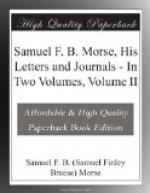Morse was now preparing to go to Europe with Smith to endeavor to secure patents abroad, and, while he had put in his application for a patent in this country, he requested that the issuing of it should be held back until his return, so that a publication on this side should not injure his chances abroad.
All the partners were working under high pressure along their several lines to get everything in readiness for a successful exhibition of the telegraph in Europe. Vail sent a long letter to Morse on April 18, detailing some of the difficulties which he was encountering, and Morse answered on the 24th:—
“I write in greatest haste, just to say that the boxes have safely arrived, and we shall proceed immediately to examine into the difficulties which have troubled you, but about which we apprehend no serious issue....
“If you can possibly get the circular portrule completed before we go it will be a great convenience, not to say an indispensable matter, for I have just learned so much of Wheatstone’s Telegraph as to be pretty well persuaded that my superiority over him will be made evident more by the rapidity with which I can make the portrule work than in almost any other particular.”
At last every detail had been attended to, and in a postscript to a letter of April 28 he says: “We sail on the 16th of May for Liverpool in the ship Europe, so I think you will have time to complete circular portrule. Try, won’t you?”
CHAPTER XXV
JUNE, 1838—JANUARY 21, 1839
Arrival in England.—Application for letters patent.—Cooke and Wheatstone’s telegraph.—Patent refused.—Departure for Paris.—Patent secured in France.—Earl of Elgin.—Earl of Lincoln.—Baron de Meyendorff.—Russian contract.—Return to London.—Exhibition at the Earl of Lincoln’s.—Letter from secretary of Lord Campbell, Attorney-General. —Coronation of Queen Victoria.—Letters to daughter.—Birth of the Count of Paris.—Exhibition before the Institute of France.—Arago; Baron Humboldt.—Negotiations with the Government and Saint-Germain Railway.— Reminiscences of Dr. Kirk.—Letter of the Honorable H.L. Ellsworth.— Letter to F.O.J. Smith.—Dilatoriness of the French.
It seems almost incredible to us, who have come to look upon marvel after marvel of science and invention as a matter of course, that it should have taken so many years to convince the world that the telegraph was a possibility and not an iridescent dream. While men of science and a few far-sighted laymen saw that the time was ripe for this much-needed advance in the means of conveying intelligence, governments and capitalists had held shyly aloof, and, even now, weighed carefully the advantages of different systems before deciding which, if any, was the best. For there were at this time several different systems in the field, and Morse soon found that he would have




